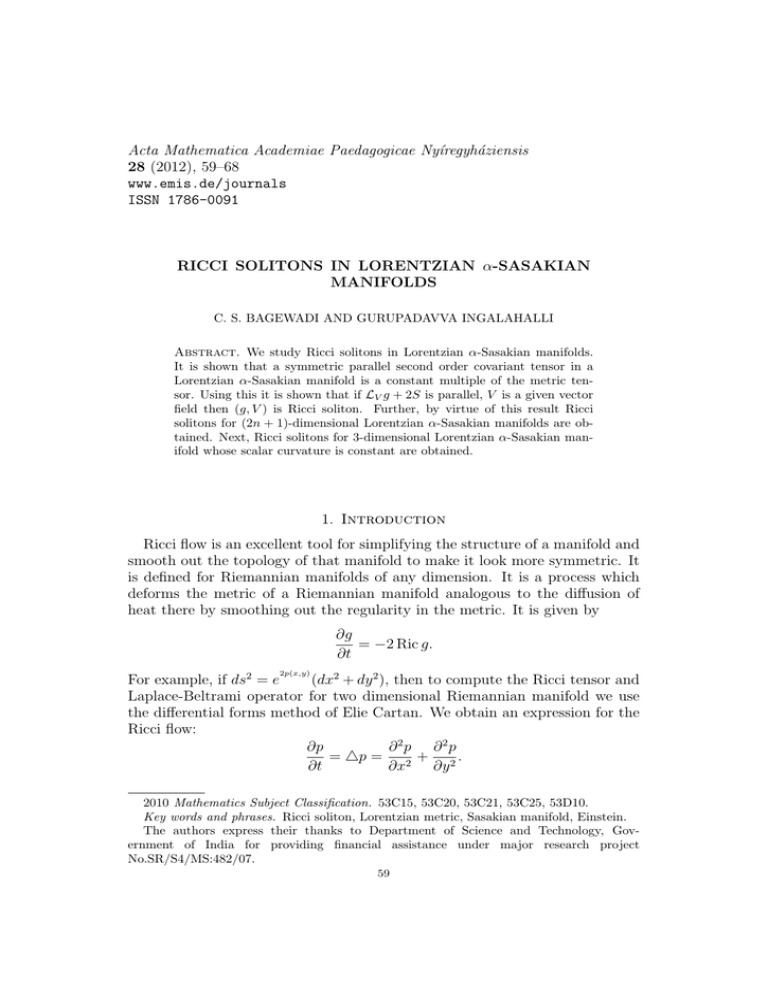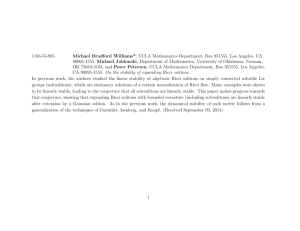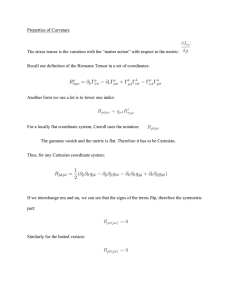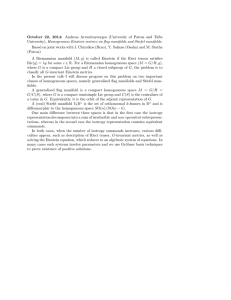Acta Mathematica Academiae Paedagogicae Ny´ıregyh´ aziensis 28 RICCI SOLITONS IN LORENTZIAN
advertisement

Acta Mathematica Academiae Paedagogicae Nyı́regyháziensis
28 (2012), 59–68
www.emis.de/journals
ISSN 1786-0091
RICCI SOLITONS IN LORENTZIAN α-SASAKIAN
MANIFOLDS
C. S. BAGEWADI AND GURUPADAVVA INGALAHALLI
Abstract. We study Ricci solitons in Lorentzian α-Sasakian manifolds.
It is shown that a symmetric parallel second order covariant tensor in a
Lorentzian α-Sasakian manifold is a constant multiple of the metric tensor. Using this it is shown that if LV g + 2S is parallel, V is a given vector
field then (g, V ) is Ricci soliton. Further, by virtue of this result Ricci
solitons for (2n + 1)-dimensional Lorentzian α-Sasakian manifolds are obtained. Next, Ricci solitons for 3-dimensional Lorentzian α-Sasakian manifold whose scalar curvature is constant are obtained.
1. Introduction
Ricci flow is an excellent tool for simplifying the structure of a manifold and
smooth out the topology of that manifold to make it look more symmetric. It
is defined for Riemannian manifolds of any dimension. It is a process which
deforms the metric of a Riemannian manifold analogous to the diffusion of
heat there by smoothing out the regularity in the metric. It is given by
∂g
= −2 Ric g.
∂t
2p(x,y)
For example, if ds2 = e
(dx2 + dy 2 ), then to compute the Ricci tensor and
Laplace-Beltrami operator for two dimensional Riemannian manifold we use
the differential forms method of Elie Cartan. We obtain an expression for the
Ricci flow:
∂ 2p ∂ 2p
∂p
= 4p =
+
.
∂t
∂x2 ∂y 2
2010 Mathematics Subject Classification. 53C15, 53C20, 53C21, 53C25, 53D10.
Key words and phrases. Ricci soliton, Lorentzian metric, Sasakian manifold, Einstein.
The authors express their thanks to Department of Science and Technology, Government of India for providing financial assistance under major research project
No.SR/S4/MS:482/07.
59
60
C. S. BAGEWADI AND GURUPADAVVA INGALAHALLI
This is manifestly analogous to the best known of all diffusion equations, the
heat equation that is,
∂T
∂ 2T
∂2T
= 4T =
+
,
∂t
∂x2
∂y 2
where now 4 = Dx2 + Dy2 is the usual Laplacian on the Euclidean plane.
Let X(t) be a time dependent family of smooth vector fields on M generated
by a family of diffeomorphisms {φt : t ∈ R} that is one parameter group of
transformations, then the relation between f : M → R and {φt : t ∈ R} is
df ◦ φt
X(φt (p))f =
(p).
dt
Let σ(t) be a smooth function of time. Since φt : M → M is a diffeomorphism and g(t) is a Riemannian metric on M (codomain) then by definition
of pull back φ∗t g(t) is a metric on M (domain).
Set g̃(t) = σ(t)φ∗t (g(t)) then we have [21]
∂g
∂g̃
0
(1.1)
= σ (t)φ∗t (g(t)) + σ(t)φ∗t
+ σ(t)φ∗t (LX g).
∂t
∂t
Suppose we have a metric g0 , a vector field Y and λ ∈ R (all independent
of time) such that
(1.2)
LY g0 + 2 Ric g0 + 2λg0 = 0.
1
If we choose g(t) = g0 , σ(t) = 1 − 2λt and X(t) = σ(t)
Y which gives a family of
diffeomorphisms φt with φ0 identity then using (1.2) in (1.1) g̃ defined above
is a Ricci flow with g(0) = g0 that is
∂g̃
(1.3)
= −2 Ric g̃.
∂t
Hence LX g0 + 2 Ric g0 + 2λg0 = 0 is a solution of the Ricci flow and is known
as Ricci soliton.
Hereafter, we use the notation S instead of Ric for Ricci tensor.
Thus a Ricci soliton on a Riemannian manifold is defined by
(1.4)
LX g + 2S + 2λg = 0.
It is said to be shrinking, steady or expanding according as λ < 0, λ = 0 and
λ > 0.
An η-Ricci soliton introduced in the paper [3] as a data (g, V, λ, µ) :
(1.5)
LV g + 2S + 2λg + 2µη ⊗ η = 0.
1.1. Example (Hamilton Cigar Soliton). Let M = R2 and φt : R2 → R2
defined by φt (x, y) = (e−2t x, e−2t y) forms a family of one parameter
group of
∂
∂
+ y ∂y
.
diffeomorphisms. The vector field X generated by {φt } is X = −2 x ∂x
2
2
2
2
dx +dy
dx +dy
∗
The metric g0 is obtained as g0 = 1+x
2 +y 2 , g̃(t) = φt (g0 ) = e4t +x2 +y 2 , Ric g0 =
2
g , LX g0 = 1+x42 +y2 g0 . Using (1.4) we have λ = 0. Hence this Ricci
1+x2 +y 2 0
RICCI SOLITONS
61
soliton is steady and is called cigar soliton because it is a asymptotic to a flat
cylinder at infinity.
In 1923, Eisenhart [7] proved that if a positive definite Riemannian manifold
(M, g) admits a second order parallel symmetric covariant tensor other than
a constant multiple of the metric tensor, then it is reducible. In 1925, Levy
[12] has obtained the necessary and sufficient conditions for the existence of
such tensors. Recently Sharma [9] and [19] has generalized Levy’s result by
showing that a second order parallel(not necessarily symmetric and non singular) tensor on an n-dimensional (n > 2) space of constant curvature is a
constant multiple of the metric tensor. Sharma has also proved in [16] that on
a Sasakian manifold there is no nonzero parallel 2-form. In 1964, Y. Wong [23]
proved that the existence of linear connections w.r.t which given tensor fields
are parallel or recurrent. Also the parallelism of h is involved and appears in
his paper as the theory of totally geodesic maps, and ∇h = 0 is equivalent with
the fact that I : (M, g) → (M, h) is a totally geodesic map. In 2007, Lovejoy
Das [5] in his paper proved that a second order symmetric parallel tensor on an
α-K-contact (α ∈ R0 ) manifold is a constant multiple of the associated metric
tensor and he also proved that there is no nonzero skew symmetric second
order parallel tensor on an α-Sasakian manifold.
Constantin Calin and Mircea Crasmareanu [2] have extended the Eisenhart
problem to Ricci solitons in f -Kenmotsu manifolds. They have studied the case
of f -Kenmotsu manifolds satisfying a special condition called regular and show
that a symmetric parallel tensor field of second order is a constant multiple of
the Riemannian metric. Using this result they have obtained results on Ricci
solitons concerned to f -Kenmotsu manifolds and 3-dimensional β-Kenmotsu
manifolds.
2. Basic concepts of Lorentzian α-Sasakian manifolds
A differentiable manifold of dimension (2n + 1) is called Lorentzian αSasakian manifold if it admits a (1, 1) tensor field φ, a vector field ξ and
1-form η and Lorentzian metric g which satisfy on M respectively such that,
(2.1)
φ2 = I + η ⊗ ξ, η(ξ) = −1, η ◦ φ = 0, φξ = 0,
(2.2)
g(φX, φY ) = g(X, Y ) + η(X)η(Y ), g(X, ξ) = η(X),
(2.3)
∇X ξ = αφX, (∇X η)Y = αg(φX, Y ),
where ∇ denotes the operator of covariant differentiation with respect to the
Lorentzian metric g on M .
Further, on an Lorentzian α-Sasakian manifold M the following relations
hold:
(2.4)
(2.5)
(2.6)
R(X, Y )ξ = α2 [η(Y )X − η(X)Y ],
R(ξ, X)Y = α2 [g(X, Y )ξ − η(Y )X],
S(X, ξ) = 2nα2 η(X),
62
C. S. BAGEWADI AND GURUPADAVVA INGALAHALLI
Qξ = 2nα2 ξ,
S(ξ, ξ) = −2nα2 ,
(2.7)
(2.8)
where α is some constant, R is the Riemannian curvature, S is the Ricci
curvature and Q is the Ricci operator given by S(X, Y ) = g(QX, Y ).
2.1. Example. We consider the 3-dimensional manifold M = {(x, y, z) ∈
R3 }, where (x, y, z) are the standard co-ordinates in R3 . Let {E1 , E2 , E3 } be
linearly independent global frame field on M given by
E1 = ez
(2.9)
∂
∂
∂
∂
, E2 = ez (
+
), E3 = k .
∂y
∂x ∂y
∂z
Let g be the Riemannian metric defined by
g(E1 , E2 ) = g(E2 , E3 ) = g(E1 , E3 ) = 0,
g(E1 , E1 ) = g(E2 , E2 ) = 1, g(E3 , E3 ) = −1,
where g is given by
1
1
[dx ⊗ dx + dy ⊗ dy] − 2 dz ⊗ dz.
2z
e
k
The (φ, ξ, η) is given by
g=
1
∂
dz, ξ = E3 = k , φE1 = −E1 , φE2 = −E2 , φE3 = 0.
k
∂z
The linearity property of φ and g yields that
η=
η(E3 ) = −1, φ2 U = U + η(U )E3 , g(φU, φW ) = g(U, W ) + η(U )η(W ),
for any vector fields U, W on M . By definition of Lie bracket, we have
[E1 , E2 ] = 0, [E1 , E3 ] = −kE1 , [E2 , E3 ] = −kE2 .
Let ∇ be Levi-Civita connection with respect to the above metric g given by
Koszul formula
(2.10) 2g(∇X Y, Z) = X(g(Y, Z)) + Y (g(Z, X)) − Z(g(X, Y ))
− g(X, [Y, Z]) − g(Y, [X, Z]) + g(Z, [X, Y ]).
Then
(2.11)
∇E1 E1 = −kE3 , ∇E1 E2 = 0, ∇E1 E3 = −kE1 ,
∇E2 E1 = 0, ∇E2 E2 = −kE3 , ∇E2 E3 = −kE2 ,
∇E3 E1 = 0, ∇E3 E2 = 0, ∇E3 E3 = 0.
The tangent vectors X P
and Y to M are expressed
as linear combination of
P
E1 , E2 , E3 , that is X = 3i=1 ai Ei and Y = 3i=1 bi Ei where ai , bi (i = 1, 2, 3)
are scalars. Clearly (φ, ξ, η, g) and X, Y satisfy equations (2.1), (2.2) and (2.3)
with α = k. Thus M is a Lorentzian α-Sasakian manifold.
RICCI SOLITONS
63
Definition 1. Let M be a Riemannian manifold with metric g, ξ an unitary
vector field, η the 1-form dual to ξ. Further, let h a symmetric tensor field
of (0, 2)-type on M which we suppose to be parallel with respect to ∇ that is
∇h = 0. Applying the Ricci identity [16]
(2.12)
∇2 h(X, Y ; Z, W ) − ∇2 h(X, Y ; W, Z) = 0,
we obtain the relation [16]:
(2.13)
h(R(X, Y )Z, W ) + h(Z, R(X, Y )W ) = 0,
then by taking Z = W = ξ in (2.13) it reduces to
(2.14)
A[η(Y )h(X, ξ) − η(X)h(Y, ξ)] = 0,
(2n+1)
where A 6= 0 is some scalar function then M is called regular (that is MA
is called regular if A 6= 0).
(ξ)
3. Parallel symmetric second order tensors and Ricci solitons
in Lorentzian α-Sasakian manifolds
Fix h a symmetric tensor field of (0, 2)-type which we suppose to be parallel
with respect to ∇ that is ∇h = 0. Applying the Ricci identity [16] in (2.12)
we obtain (2.13). Replacing Z = W = ξ in (2.13) and using (2.4) and by the
symmetry of h, we have
(3.1)
2α2 [η(Y )h(X, ξ) − η(X)h(Y, ξ)] = 0.
Put X = ξ in (3.1), we have
(3.2)
2α2 [η(Y )h(ξ, ξ) + h(Y, ξ)] = 0.
Since 2α2 6= 0, by definition (1) Lorentzian α-Sasakian manifold is regular.
By (3.2), we have
(3.3)
h(Y, ξ) = −η(Y )h(ξ, ξ).
Differentiating (3.3) covariantly with respect to X, we have
(3.4)
(∇X h)(Y, ξ) + h(∇X Y, ξ) + h(Y, ∇X ξ) =
− [(∇X η)(Y ) + η(∇X Y )]h(ξ, ξ)
− η(Y )[(∇X h)(ξ, ξ) + 2h(∇X ξ, ξ)].
By using (2.2), (2.3) and (3.3), we have
(3.5)
−h(Y, φX) = g(Y, φX)h(ξ, ξ),
we deduce the above equation then we have
(3.6)
h(X, Y ) = −g(X, Y )h(ξ, ξ),
which together with the standard fact that the parallelism of h implies the
h(ξ, ξ) is a constant and via (3.3) yields the following:
Theorem 3.1. A symmetric parallel second order covariant tensor in a regular
Lorentzian α-Sasakian manifolds is a constant multiple of the metric tensor.
64
C. S. BAGEWADI AND GURUPADAVVA INGALAHALLI
Corollary 1. A locally Ricci symmetric (∇S = 0) regular Lorentzian αSasakian manifolds is an Einstein manifold.
Remark: The following statements for Lorentzian α-Sasakian manifolds are
equivalent. The manifold is
(i) Einstein
(ii) locally Ricci symmetric
(iii) Ricci semi-symmetric that is R · S = 0.
The implication (i) =⇒ (ii) =⇒ (iii) is trivial. Now we prove the implication
(iii) =⇒ (i) and R · S = 0 means exactly (2.13) with replaced h by S that is
(3.7)
(R(X, Y ) · S)(U, V ) = −S(R(X, Y )U, V ) − S(U, R(X, Y )V ).
Considering R · S = 0 and putting X = ξ in equation (3.7), we have
(3.8)
S(R(ξ, Y )U, V ) + S(U, R(ξ, Y )V ) = 0.
By using (2.5) and (2.6), we obtain
(3.9) 2nα4 g(Y, U )η(V ) − α2 η(U )S(Y, V ) + 2nα4 g(Y, V )η(U )
− α2 η(V )S(U, Y ) = 0.
Again by putting U = ξ in the above equation and by using (2.1), (2.2) and
(2.6), we obtain
(3.10)
S(Y, V ) = 2nα2 g(Y, V ).
In conclusion:
Proposition 1. A Ricci semi-symmetric regular Lorentzian α-Sasakian manifolds is Einstein.
We close this section with applications of our Theorem to Ricci solitons:
Corollary 2. Suppose that on a regular Lorentzian α-Sasakian manifolds the
(0, 2)-type field LV g + 2S is parallel where V is a given vector field. Then
(g, V ) yield a Ricci soliton. In particular, if the given regular Lorentzian αSasakian manifold is Ricci-semi symmetric with LV g parallel, we have the same
conclusion.
Proof. Follows from Theorem 3.1 and Corollary 1.
Naturally, two situations appear regarding the vector field V : V ∈ Span ξ
and V ⊥ ξ but the second class seems far too complex to analyse in practice.
For this reason it is appropriate to investigate only the case V = ξ.
We are interested in expressions for Lξ g+2S. A straightforward computation
gives
(3.11)
(Lξ g)(X, Y ) = 2αg(φX, Y ).
RICCI SOLITONS
65
The metric g is called η-Einstein if there exists two real functions a and b
such that the Ricci tensor of g is
(3.12)
S(X, Y ) = ag(X, Y ) + bη(X)η(Y ).
Let ei = 1, 2, . . . , (2n + 1) be an orthonormal basis of the tangent space at
any point of the manifold. Then putting X = Y = ei in (3.12) and taking
summation over i then we get
r = (2n + 1)a − b.
(3.13)
Again putting X = Y = ξ in (3.12) then by using (2.1), (2.2) and (2.8), we
have
−a + b = −2nα2 ,
(3.14)
from (3.13) and (3.14), we obtain the values of a and b
r
r
a=
− α2 , b =
− (2n + 1)α2 .
2n
2n
Substituting the values of a and b in (3.12), we have
h r
i
h r
i
(3.15) S(X, Y ) =
− α2 g(X, Y ) +
− (2n + 1)α2 η(X)η(Y ).
2n
2n
The above equation shows that Lorentzian α-Sasakian manifold is η-Einstein.
For (2n + 1)-dimensional Lorentzian α-Sasakian manifolds, we have
(3.16)
h(X, Y ) = (Lξ g)(X, Y ) + 2S(X, Y ).
Then in (3.16) substituting the values of (3.11) and (3.15), we have
i
hr
2
− 2α g(X, Y )
(3.17) h(X, Y ) = 2αg(φX, Y ) +
n
hr
i
+
− 2(2n + 1)α2 η(X)η(Y ).
n
Differentiating the above equation (3.17) with respect to Z then we have
(3.18)
(∇Z h)(X, Y ) =
∇Z r
2(Zα)g(φX, Y ) +
− 4α(Zα) g(X, Y )
n
∇Z r
+
− 4(2n + 1)α(Zα)) η(X)η(Y ) + 2αg((∇Z φ)X, Y )
n
i
hr
− 2(2n + 1)α2 {αg(X, φZ)η(Y ) + αg(Y, φZ)η(X)},
+
n
by substituting Z = ξ and X = Y ∈ (Span ξ)⊥ in the above equation, we have
(3.19)
∇ξ r = 0,
provided h is parallel. Thus r is constant scalar, then we state that:
Proposition 2. An η-Einstein Lorentzian α-Sasakian Ricci soliton (g, ξ, λ)
with constant scalar curvature r is shrinking.
66
C. S. BAGEWADI AND GURUPADAVVA INGALAHALLI
Proof. From equation (1.4) and (3.16), we have
h(X, Y ) = −2λg(X, Y ).
Putting X = Y = ξ in the above equation, we have
(3.20)
h(ξ, ξ) = 2λ.
Now considering (3.17), that is
hr
i
hr
i
2
2
h(X, Y ) = 2αg(φX, Y ) +
− 2α g(X, Y ) +
− 2(2n + 1)α η(X)η(Y ).
n
n
Putting X = Y = ξ in the above equation, we have
h(ξ, ξ) = −4nα2 .
(3.21)
By equating (3.20) and (3.21), we have
λ = −2nα2 .
(3.22)
This shows that λ < 0 that is the Ricci soliton in (2n + 1)-dimensional
Lorentzian α-Sasakian is shrinking.
We compute an expression for Ricci tensor for 3-dimensional Lorentzian
α-Sasakian manifold as follows: The curvature tensor for 3-dimensional Riemannian manifold is given by
(3.23) R(X, Y )Z = g(Y, Z)QX − g(X, Z)QY + S(Y, Z)X − S(X, Z)Y
r
− [g(Y, Z)X − g(X, Z)Y ],
2
put Z = ξ in the above equation that is in (3.23) and by using (2.2), (2.4) and
(2.6), we obtain
hr
i
(3.24)
− α2 [η(Y )X − η(X)Y ] = η(Y )QX − η(X)QY.
2
Again put Y = ξ in the equation (3.24) and by using (2.1) and (2.7), we have
hr
i
hr
i
(3.25)
QX =
− α2 X +
− 3α2 η(X)ξ
2
2
and
hr
i
hr
i
2
2
(3.26)
S(X, Y ) =
− α g(X, Y ) +
− 3α η(X)η(Y ),
2
2
where r is the scalar curvature and α is a constant.
For a 3-dimensional Lorentzian α-Sasakian manifolds, we obtain
(3.27)
h(X, Y ) = (Lξ g)(X, Y ) + 2S(X, Y ).
By using (3.11) and (3.26) in (3.27), we have
(3.28) h(X, Y ) = 2αg(φX, Y ) + [r − 2α2 ]g(X, Y ) + [r − 6α2 ]η(X)η(Y ).
Differentiating the above equation with respect to Z then we have
(3.29)
(∇Z h)(X, Y ) =
2(Zα)g(φX, Y ) + 2αg((∇Z φ)X, Y ) + [∇Z r − 4α(Zα)]g(X, Y )
RICCI SOLITONS
67
+ [∇Z r − 6(2α(Zα))]η(X)η(Y ) + (r − 6α2 )[αg(X, φZ)η(Y )
+ αg(Y, φZ)η(X)].
Substituting Z = ξ, X = Y ∈ (Span ξ)⊥ in (3.29) then we have
∇ξ r = 0,
(3.30)
provided h is parallel. Thus r is constant scalar, then we state that:
Proposition 3. A Ricci soliton (g, ξ, λ) in 3-dimensional Lorentzian α-Sasakian
manifold with constant scalar curvature r is shrinking.
Proof. From equation (1.4) and (3.27), we have
h(X, Y ) = −2λg(X, Y ).
Putting X = Y = ξ in the above equation, we have
(3.31)
h(ξ, ξ) = 2λ.
Now considering (3.28), that is
h(X, Y ) = 2αg(φX, Y ) + [r − 2α2 ]g(X, Y ) + [r − 6α2 ]η(X)η(Y ).
Putting X = Y = ξ in the above equation, we have
(3.32)
h(ξ, ξ) = −4α2 .
By equating (3.31) and (3.32), we have
(3.33)
λ = −2α2 .
This shows that λ < 0 that is the Ricci soliton in 3-dimensional Lorentzian
α-Sasakian is shrinking.
Acknowledgement. The authors are grateful to the referee in revising the
paper.
References
[1] C. S. Bagewadi and Venkatesha. Some curvature tensors on a trans-Sasakian manifold.
Turkish J. Math., 31(2):111–121, 2007.
[2] C. Călin and M. Crasmareanu. From the Eisenhart problem to Ricci solitons in f Kenmotsu manifolds. Bull. Malays. Math. Sci. Soc. (2), 33(3):361–368, 2010.
[3] J. T. Cho and M. Kimura. Ricci solitons and real hypersurfaces in a complex space
form. Tohoku Math. J. (2), 61(2):205–212, 2009.
[4] B. Chow, P. Lu, and L. Ni. Hamilton’s Ricci flow, volume 77 of Graduate Studies in
Mathematics. American Mathematical Society, Providence, RI, 2006.
[5] L. Das. Second order parallel tensors on α-Sasakian manifold. Acta Math. Acad. Paedagog. Nyházi. (N.S.), 23(1):65–69 (electronic), 2007.
[6] U. C. De and M. M. Tripathi. Ricci tensor in 3-dimensional trans-Sasakian manifolds.
Kyungpook Math. J., 43(2):247–255, 2003.
[7] L. P. Eisenhart. Symmetric tensors of the second order whose first covariant derivatives
are zero. Trans. Amer. Math. Soc., 25(2):297–306, 1923.
[8] A. Ghosh and R. Sharma. Some results on contact metric manifolds. Ann. Global Anal.
Geom., 15(6):497–507, 1997.
68
C. S. BAGEWADI AND GURUPADAVVA INGALAHALLI
[9] A. Ghosh, R. Sharma, and J. T. Cho. Contact metric manifolds with η-parallel torsion
tensor. Ann. Global Anal. Geom., 34(3):287–299, 2008.
[10] X.-q. Jia. Second order parallel tensors on quasi-constant curvature manifolds. Chinese
Quart. J. Math., 17(2):101–105, 2002.
[11] K. Kenmotsu. A class of almost contact Riemannian manifolds. Tôhoku Math. J. (2),
24:93–103, 1972.
[12] H. Levy. Symmetric tensors of the second order whose covariant derivatives vanish.
Ann. of Math. (2), 27(2):91–98, 1925.
[13] J. C. Marrero. The local structure of trans-Sasakian manifolds. Ann. Mat. Pura Appl.
(4), 162:77–86, 1992.
[14] Z. Olszak and R. Roşca. Normal locally conformal almost cosymplectic manifolds. Publ.
Math. Debrecen, 39(3-4):315–323, 1991.
[15] C. Oniciuc. Nonlinear connections on tangent bundle and harmonicity. Ital. J. Pure
Appl. Math., (6):109–122 (2000), 1999.
[16] R. Sharma. Second order parallel tensor in real and complex space forms. Internat. J.
Math. Math. Sci., 12(4):787–790, 1989.
[17] R. Sharma. Second order parallel tensors on contact manifolds. Algebras Groups Geom.,
7(2):145–152, 1990.
[18] R. Sharma. Second order parallel tensors on contact manifolds. II. C. R. Math. Rep.
Acad. Sci. Canada, 13(6):259–264, 1991.
[19] R. Sharma. Certain results on K-contact and (k, µ)-contact manifolds. J. Geom., 89(12):138–147, 2008.
[20] S. Tanno. The automorphism groups of almost contact Riemannian manifolds. Tôhoku
Math. J. (2), 21:21–38, 1969.
[21] P. Topping. Lectures on the Ricci flow, volume 325 of London Mathematical Society
Lecture Note Series. Cambridge University Press, Cambridge, 2006.
[22] M. M. Tripathi. Ricci solitons in contact metric manifolds. arXiv:0801.4222.
[23] Y.-c. Wong. Existence of linear connections with respect to which given tensor fields
are parallel or recurrent. Nagoya Math. J., 24:67–108, 1964.
[24] A. Yildiz, M. Turan, and B. E. Acet. On three-dimensional Lorentzian α-Sasakian
manifolds. Bull. Math. Anal. Appl., 1(3):90–98, 2009.
[25] G. Zhao. Symmetric covariant tensor fields of order 2 on pseudo-Riemannian manifolds.
Technical report, Viena Preprint ESI 479, 1997.
Received March 14, 2011.
Department of Mathematics,
Kuvempu University,
Shankaraghatta - 577 451, Shimoga, Karnataka, INDIA
E-mail address: prof bagewadi@yahoo.co.in
E-mail address: gurupadavva@gmail.com




